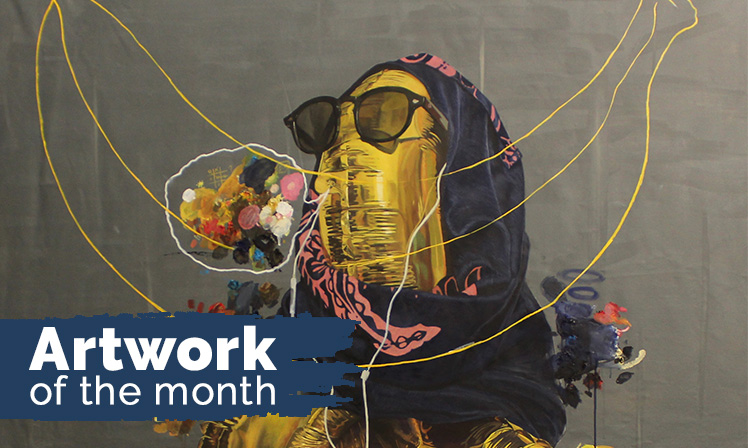Against what looks like a polished concrete wall, the main lady in Melimpah practically shines.
At first glance, she looks styled from a tuba. But more likely, her provenance tracks to a contorted balloon, the glossy kind you fill with helium.
It is a busy piece. From her ears a pair of earphones dangle, while her mouth is pegged to a speech bubble filled with flowers and a hand-drawn tic-tac-toe panel. Sunglasses and a beach pareo draped around her head casually suggest some hijabista chic via a day at the beach. She is essentially faceless, but cuts a disembodied feminine figure thanks to the accessories.
Melimpah deftly exemplifies Ruzzeki Harris’ style, which has been described as Figurative and Pop Surrealism. He tends to juxtapose the drab with the vivacious, for example in Sweet Promises, where a stained brown background has bursts of red ribbons surrounding a grey painting of a skull. A few commentators have said his influences point to Salvador Dali, and his works possess a common thread of social critique.
For example, his portfolio on display on the Artemis Art Gallery website showcases the transfixing effect of communication devices. Young children and adolescents gaze animatedly into screens, and strategically placed outlines of boxes and cages tell us all we need to know. But there is also joy in just looking at Ruzzeki’s works, trying to discern and decipher what pops out.
Back to Melimpah, two large outlines of a banana are curious accompaniments. One of them overlaps with the bottom half of the lady’s face. One interpretation: the omnipresent phallic forces, even when they’re not the main topic. Is Melimpah a commentary on patriarchy’s unflinching grip on (young) women who are just going about their day, being comfortable in their own skin?
Perhaps, it is just a banana.

